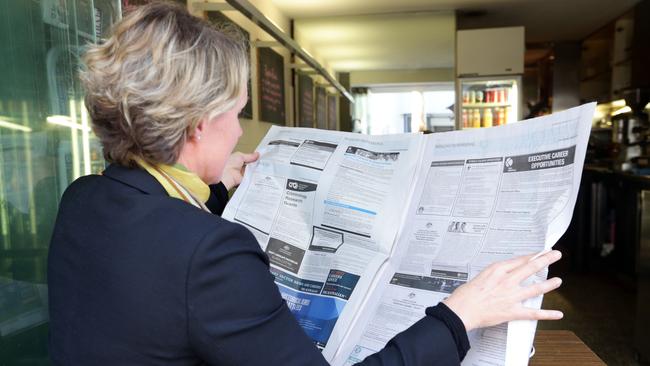Males at the tip of unemployment iceberg

ECONOMISTS’ predictions that the unemployment rate would head up towards 6.5 per cent this year were right on track. Jobs have been lost right across Australia’s working-family commuter belt but they aren’t showing up in unemployment statistics yet because there are no jobs for them to chase.
We estimate that between 60,000 and 75,000 men joined the hidden unemployed during the past 12 months. This is about 1 per cent of the male workforce or 0.5 per cent of the total workforce, and it would have taken the unemployment rate up to 6.3 per cent for the end of May.
We are talking about married men in two-income, established families who aren’t familiar with unemployment or Centrelink and have limited potential to relocate, with their older children in local secondary schools. These men belong to mainstream working families — middle income, middle-aged, mainstream mortgages or rents, driving themselves to work.
Well, they used to drive themselves to work in full-time wholesale or retail jobs but instead they’re keeping a stressed eye on the jobs market and the mortgage offset account, walking the two kids to school and networking with the other dads about play dates for the kids after the first bell.
During the 12 months to May, year-on-year employment growth was 99,400, unemployment growth was 43,000 and “not in the labour force” growth was 197,500. Given our long-term participation rates of 65 per cent and unemployment rates of about 5 per cent, we should have seen employment growth of 210,000, unemployment growth of 10,000 and “not in the labour force growth” of 120,000. So our employment growth was about 110,000 too low, unemployment growth was 30,000 too high and “not in the labour force” was 80,000 too high.
ADS jobs profile for May Quarter 2014
Year-on-year increases of those “not in the labour force” includes students and retirees but also the hidden unemployed: discouraged workers who have lost their jobs but had not been actively seeking work during the survey period or were not ready to start work immediately. They could have a working partner, some savings or supportive parents or find it difficult to relocate at short notice to a different work region.
Long-term job losses for men have been under way for some time and it is directly linked to the impact of the global financial crisis, the stimulus and the re-regulation of the Australian labour market.
As the impact of the GFC began to peter out in May 2010, 64.9 per cent of full-time jobs were held by men, but in the four years since, only 54.6 per cent of additional full-time jobs were won by men.
When we include part-time jobs, in the past four years men have gained only 46.3 per cent of all new jobs, pulling down the percentage of males in the total workforce from 54.6 per cent to 54.1 per cent.
Since May 2010 the participation rate for women has increased by 0.4 per cent, from 58.4 per cent to 58.8 per cent, while the participation rate for men has dropped by 1.2 per cent, from 72.1 per cent to 70.9 per cent.
Despite this disproportionate loss of jobs by men, women rather than men dominate those who are unemployed but actively seeking work, while men losing jobs have been increasingly sliding into the ranks of the hidden unemployed.
In the past 12 months, twice as many women (96,600) as men (45,800) joined the labour force and almost twice as many men (124,100) as women (73,300) left the labour market. This represents a loss of up to 75,000 male jobs in the past year.
Women appear to have been hit more by underemployment, rather than a direct loss of jobs. Underemployment tends to measure women with part-time jobs who can’t find enough work. This deprives them of the additional family income to pay for discretionary spending on restaurants, holidays or school fees. If their family income is high enough, some drop out and join the hidden unemployed.
Since interest rates began to fall in August 2011, older savers have been losing ground in the jobs market to younger borrowers. And thanks to the boomer age bulge the ratio of losers to winners is a lot higher than it used to be.
As the losers in this equation, many women in their late 50s have had to rejoin the workforce to supplement declining family transition to retirement income.
The underemployment rate for these older women has overtaken that for 25 to 34-year-old women and is now at 7.5 per cent — well above GFC levels in mid-2009 of 6.4 per cent.
These women would be very unhappy about cuts to pension indexation and rising retirement ages foreshadowed in the budget.
Drilling down into industries
DURING the past 12 months, we have seen 153,880 more men hired in agriculture, mining, construction, real estate, professional consulting, education, health and services, while 120,700 men have been leaving jobs in utilities, wholesale, retail, hospitality, transport, media, finance, public administration and arts and recreation, producing a net 33,100 extra jobs for men in that period.
Women gained fewer jobs in the past year than men did (116,200 compared with 153,880) in industries such as real estate, professional consulting, public administration and services, but lost far fewer jobs than men (50,700 compared with 120,700) in media, health, and arts and recreation.
In net terms, women won two out of every three jobs created in the past year (65,500 compared with 33,100) because of their success in winning public admin and real estate jobs and by not losing as many private-sector jobs as men did in wholesale, retail and hospitality.
Workers in health, education and public admin industries are likelier than the average worker to be taxpayer-funded, members of a white-collar union, female, and vote Labor or Green. Under Labor and the Greens, between November 2007 and September 2013, these industries gained more than a half-million new jobs, moving from 23.7 per cent of the workforce to 26.5 per cent.
The Labor governments of Kevin Rudd and Julia Gillard didn’t have a labour force strategy as such but, rather, a publicly funded strategy to increase the membership of the ACTU and tickle the tummy of the Greens at the same time. The numbers involved in the growth of health and social assistance jobs at federal and state levels after the GFC are simply staggering and bear little relationship to the progressive ageing of the population.
Health and social assistance job numbers exploded during the stimulus cash splash of 2008-09, growing by 167,700 between the election of Rudd in November 2007 and Gillard’s dead heat with Tony Abbott in August 2010. Without these extra health jobs absorbing up to 1.5 per cent of the August 2010 unemployment figures, it is hard to imagine Abbott losing his first election in 2013 if it had been fought with an unemployment rate of 6.3 per cent, rather than the actual 4.8 per cent.
Health and social assistance picked up 272,700 jobs between the 2007 and 2013 elections, which was nearly one-third of all jobs created across the entire workforce. About 31 per cent of workers in this industry tend to be members of white-collar unions.
The education unions mounted an extraordinarily clever campaign to ensure they covered every worker looking after children from the age of six weeks to 18 years and their numbers grew 91,200 with another 145,100 public servants to oversee this growing empire. During Labor’s two terms in office, 61 per cent of all new jobs were in these three industries.
But we need to remember that Rudd said he wanted to be prime minister of a country that still made things. Well, of the workers who make things, those in manufacturing, construction and transport industries tend to be private sector, belong to ALP affiliated unions, male, and vote Labor.
Under Labor’s protectionist industry polices, these industries lost 25,000 workers in absolute terms and fell from 24.1 per cent of the workforce in 2007 to 22.2 per cent in September 2013.
So the costly protection and factional featherbedding of ALP affiliated jobs by Labor governments served only to reduce the numbers of blue-collar men in private-sector jobs.
Men in Labor-affiliated unions lost jobs in real terms because of the jobs strategy of the government they elected to look after them. This government included for its final two years under both Rudd and Gillard their loyal minister for workplace relations Bill Shorten, now Opposition Leader.
In recent months the workforce proportion of both of these female white-collar and male blue-collar industry groups has fallen, with a slowdown in public service growth and cuts to protected blue-collar jobs in the private sector. These six industries make up nearly half the total Australian workforce, they often comprise both parents of the same working families and they completely dominate Australia’s commuter belt. No government can get re-elected without their support.
During the Labor years, the economy underwent a fundamental restructuring as a result of the mining boom but the dollars were used by Labor to grow the public sector workforce and prop up labour market statistics for the World’s Best Treasurer, Wayne Swan.
The incoming government is addressing this economic imbalance but it is cutting demand in a declining labour market, with its private-sector recovery hamstrung by the re-regulation of 2007 to last year.
Regions that lost the most jobs in the year to May cover a cross-section of Australia, from selected inner suburbs of Melbourne and North Sydney, to middle-class commuter regions in Sydney and Perth, to blue-collar outer suburbs of Brisbane, Adelaide and Perth, and farther out from the CBD to provincial cities in NSW, Victoria and Queensland. We are looking at pockets of older empty-nesters and some students in the inner cities, retail salespeople and self-drive commuters in the middle-class commuter suburbs, low income males who could be driving a truck to work in the outer suburbs and older homeowners in the provincial cities.
These are big, mainstream demographics, led by the six out of 10 workers who drive themselves to work.
The regions doing well are biased towards Queensland, with six out of the state’s 19 regions performing strongly. We have some higher income inner-city regions from Brisbane and Perth and from most states we have outer-suburban regions, provincial city regions and remote and rural regions.
Demographically we see across these regions young, mobile voters, prepared to travel to find work. This includes travel to mining regions where they join indigenous Australians in those workforces.
The younger groups are heavily biased towards migrants from Ireland and other Anglophone countries, such as Canada, the US, Singapore and New Zealand. Their homes are rented, their web access comes from mobile phones or tablets, their partnering relationships are informal and there are no kids in sight. And welfare cheques are a lot harder to find.
The 13 regional and outer-urban mortgage belt electorates losing the most jobs could be considered to be in a serious economic downturn during the past year, with significant contraction of their local employment bases and flow-on effects on industries such as retail and hospitality.
All 13 seats are in NSW or Victoria and 10 of the 13 are represented by the Coalition, with five of them in Victoria. Of the 10 seats represented by the Coalition, five are marginal, three in NSW and two in Victoria.
The 13 electorates with strongly expanding local job markets during the past 12 months include six from NSW, one from Victoria, two from Queensland, three from Western Australia and one from the Northern Territory. Nine of the 13 seats are represented by the Coalition, three of them marginal.
T he unemployed hiding in plain view
WE define the current hidden jobless demographics by profiling regions where the past 12 months have seen employment numbers fall, but unemployment rates fall or remain neutral. So jobs have been lost but those losses have not shown up as unemployed.
We are looking at three distinct stereotypes here. The first is mainstream Australian working families, fortysomething and married. Dad has just lost his full-time job in wholesale or retail and mum, with a background in management and commerce studies, is working in a senior clerical or administration job, probably in public admin, real estate, professional consulting or services.
Mum has taken over as the principal breadwinner, driving herself to work, and dad would be looking after their outer suburban McMansion, making the kids lunches, walking them to early tennis classes and driving them to swimming training after school, fretting about the beef stew catching on the bottom of the casserole dish while he’s watching the kids do their laps. I have some form here.
The family was earning $80,000 to $135,000 a year when both parents were working and the mortgage would be $17,000 to $30,000 a year, meaning many of them were in some mortgage stress before dad lost his job.
This story does not have a happy ending — especially for governments.
The second group is working mums 55 and older, with a family and fully paid off house. They had a part-time job, then lost virtually all their working hours and now they’ve moved on, chasing a job with more hours and living off savings or their husband’s income.
The third group is single mums, possibly retraining at TAFE and navigating their way through the welfare maze, which can be a part- time job of sorts.
If there is a positive score for a measure of hidden unemployment, then there must also be a negative score, for where things are on the improve. We find this in the demographic profile of regions where in the past 12 months, employment numbers have risen and unemployment rates have also risen. This means hidden jobless numbers have been falling, as formerly discouraged workers have been moving from the “not in the labour force” group and back into the labour force, either in a job, or actively hunting for a job and able to start work straight away.
There are a number of points which stand out here. First this group is young, unattached and highly mobile. They rent their house and get their access to the web via their phone or tablet. Those on working-holiday visas seeking a second-year extension need to work in qualifying non-metro areas. If there is a new job available in a non-metro region picking fruit or in coal mining, exploration or mining services, then they are on their way. They are prepared to take jobs where they have to live away from home or live in special tenancy arrangements on farms, construction dongas or mining camps.
They aren’t big on filling in census forms, especially when it comes to telling someone from the government how much they earn or what religion they follow, although some follow the rural religions of Uniting or Lutheran.
A small number also follow traditional Aboriginal religions, which is a sign of increasing employment in real mining or agriculture jobs for indigenous Australians in remote areas.
There are a lot of young migrants in the group from English- speaking countries, such as Ireland and New Zealand. They don’t appear the type of workers who would belong to unions or be easy to sign up to them. They are self-motivated young adults who can look after themselves.
And finally, they owe very little to the Labor Party, to the labour movement or to Fair Work Australia. Or to Bill Shorten for that matter.
John Black is a former Labor senator and the chief executive of Australian Development Strategies.


